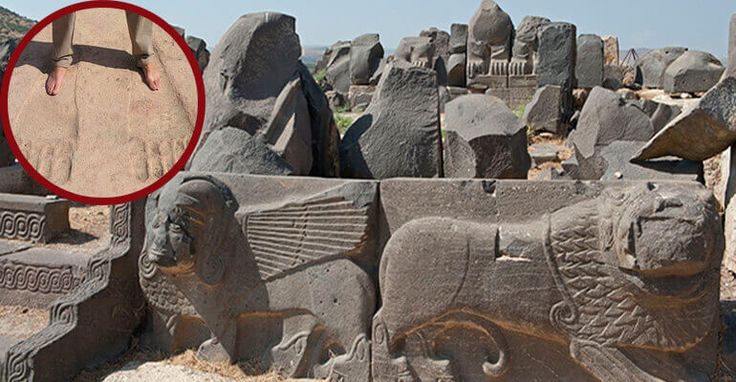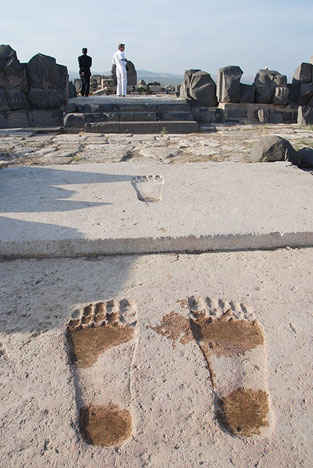Three GIANT footprints adorn the temple of Ain Dara, which is located northwest of Aleppo, Syria. Scholars are still unsure about their true function and meaning.
There is proof that Giants formerly roamed the Earth all over the world, according to legend. Many experts and authors believe that a distinct species—one of the considerably bigger proportions—existed on Earth in the distant past, despite what many people believe to be a myth. Perhaps these enormous entities were previously mistaken for gods.

Ain Dara is a small village northwest of Aleppo, Syria, noted for several noteworthy structures, including the Ain Dara Temple, which is located just west of the village. In 195, a massive basalt lion was uncovered, which led to the discovery of the temple. Excavations were carried out in the following years as a result of the discovery, unearthing significant pieces of history.
The temple of Ain Dara, according to AO, is thought to date from the Iron Age Syrian-Hittite culture. After the demise of the Hittite empire at the end of the second millennium BC, a set of political groups known as Syrian-Hittites or Neo-Hittites arose. The Syrian-Hittite nations filled a political hole in the region and became the dominant force until the Neo-Assyrian Empire conquered them around the end of the seventh century BC.
The GIGANTIC Footprints
Experts are still unsure what divinity this temple was dedicated to, despite the countless discoveries unearthed at the site, and the multitude of sculptures and bas-reliefs adorning the building’s walls make it extremely difficult for researchers to decide.

Surprisingly, there is a third enormous footprint engraved on the floor not far from the first two, practically indicating where one should proceed. So, why carve three such colossal footprints?
What exactly are these prints? Were they godlike representations? Were they put there for the sake of aesthetics? Is it possible that they’re proof of something far more shocking?
What these massive footprints are supposed to signify is still unknown. Some experts believe they are animal prints, while others believe they are gods’ footsteps.
Perhaps these gigantic markings, which measure roughly one meter in length, were meant to be a symbol of the Gods. The footprints could have been sculpted to depict the presence of a local deity entering the temple and nearing the inner sanctuary seat.

Other authors believe there is a whole different explanation, and that these footprints—along with many others discovered all around the world—are a memory of a period when Gods roamed the Earth, causing the entire planet to shudder beneath their huge feet.
Another intriguing characteristic of the temple of Ain Dara is its resemblance to the biblical account of Jerusalem’s Temple of Solomon.
These two temples were claimed to have identical floor plans, eras, sizes, and decorations.
Before jumping to the conclusion that one temple affected the other, it’s worth noting that there are other temples in the area that can be compared to Ain Dara and Solomon’s Temple.
Ebla, Emar, and Munbaqa are the names of these temples. As a result, it’s possible that these temples were part of a larger cultural heritage that dominated the region at the time.
Interestingly, Mesopotamia is well-known for being the cradle of civilization and the site of one of the world’s greatest mythological legends, thus strange and perplexing findings like the gigantic footprints are to be expected in the region.
The surrounding area’s mythology strongly depicts a time when giants, demigods, and gods roamed the region, leaving their imprint.























